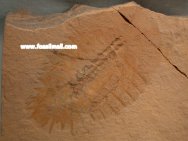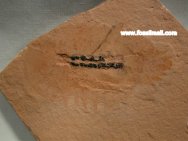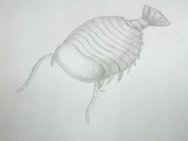 Description:
Yet another of the fantastic fossils being uncovered in the Weeks
Formation, this spiky arthropod looks to have its affinities with
Sidneyia inexpectans, a large Burgess Shale arthropod named by C.D.
Walcott for his son. It seems to have a more spiky carapace than Description:
Yet another of the fantastic fossils being uncovered in the Weeks
Formation, this spiky arthropod looks to have its affinities with
Sidneyia inexpectans, a large Burgess Shale arthropod named by C.D.
Walcott for his son. It seems to have a more spiky carapace than Sidneyia, but otherwise has many of the same features (see the reconstruction).
Like Sidneyia, the gut contents seem hard shelled, perhaps the remains
of trilobites. At any rate, seen here as a part/counterpart example,
this is a most unusual and unique specimen.
Sidneyia, but otherwise has many of the same features (see the reconstruction).
Like Sidneyia, the gut contents seem hard shelled, perhaps the remains
of trilobites. At any rate, seen here as a part/counterpart example,
this is a most unusual and unique specimen.
 The
House Range of Utah has several formations that exhibit Burgess
Shale-like preservation of soft tissues, and yield fossils of creatures
closely allied with the Burgess Shale biota. Interestingly, the
formations are normally found in alternating biofacies. Some are
rich in trilobites lacking soft bodied organisms, while adjacent
ones lack trilobites but preserve soft bodied organisms in the form
of kerogenized carbon films. Gaines (2004) has studied the taphonomy
of House Range soft tissue preservation, hypothesizing a taphonomic
pathway much like the Burgess Shale with delayed decay facilitating
rapid diagenesis in an anoxic zone lacking benthic bioturbators.
While soft bodied organisms are far rarer and generally not so exquisitely
preserved as in the Burgess Shale, some scientists believe the House
Range biota might be even more diverse. Many fossils found are enigmatic
as to their taxonomic placement. Unfortunately, the numerous sites
are much understudied, while mining operations are resulting in
wholesale destruction of a potentially rich portion of the Cambrian
fossil record. The
House Range of Utah has several formations that exhibit Burgess
Shale-like preservation of soft tissues, and yield fossils of creatures
closely allied with the Burgess Shale biota. Interestingly, the
formations are normally found in alternating biofacies. Some are
rich in trilobites lacking soft bodied organisms, while adjacent
ones lack trilobites but preserve soft bodied organisms in the form
of kerogenized carbon films. Gaines (2004) has studied the taphonomy
of House Range soft tissue preservation, hypothesizing a taphonomic
pathway much like the Burgess Shale with delayed decay facilitating
rapid diagenesis in an anoxic zone lacking benthic bioturbators.
While soft bodied organisms are far rarer and generally not so exquisitely
preserved as in the Burgess Shale, some scientists believe the House
Range biota might be even more diverse. Many fossils found are enigmatic
as to their taxonomic placement. Unfortunately, the numerous sites
are much understudied, while mining operations are resulting in
wholesale destruction of a potentially rich portion of the Cambrian
fossil record.
Related: Soft-bodied
Cambrian Explosion Biota from Utah
References:
- Briggs
D.E.G., and R.A. Robison. 1984. Exceptionally preserved non trilobite
arthropods and Anomalocaris from the Middle Cambrian of Utah.
University of Kansas Paleontological Contributions, Paper 111:1-24.
- Gaines,
Robert R.; Kennedy, Martin J. Droser, Mary L. 2004. A new hypothesis
for organic preservation of Burgess Shale taxa in the middle Cambrian
Wheeler Formation, House Range, Utah. Palaeo, 220:193-205.
- House
Range Fossils: Wheeler Shale, Marjum Formation, and Weeks Formation,
The Virtual Fossil Museum (www.fossilmuseum.net).
|